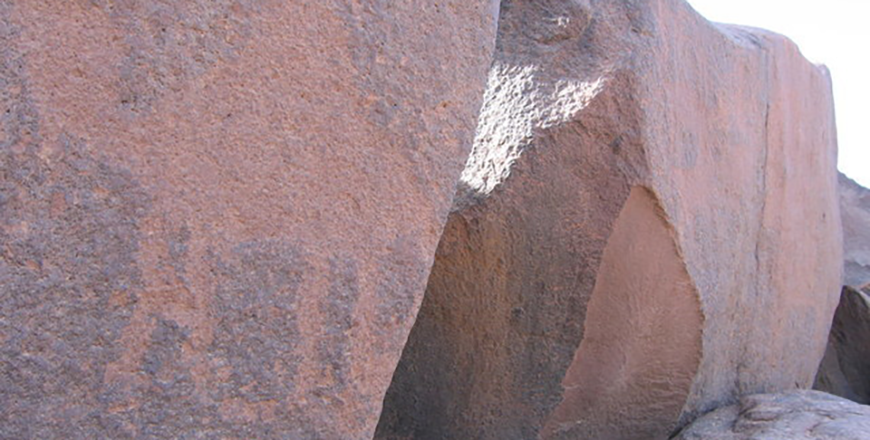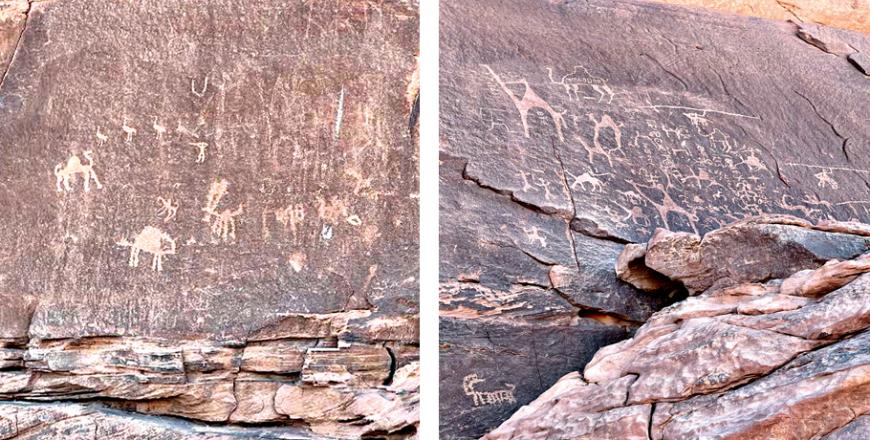You are here
Unveiling Arabia’s legendary camel through rock art, archaeological exploration
By Saeb Rawashdeh - Dec 19,2023 - Last updated at Dec 19,2023

A camel petroglyph on a rock in Wadi Rum in southern Jordan (Photo courtesy of ACOR)
AMMAN — The dromedary or one-humped camel is Arabia’s legendary animal and it features rock art from the time immemorial. But not many studies have been conducted on these images and their significance, with the main interpretations focusing on either highly functional or highly symbolic meanings.
The domesticated dromedary camel has had a dominant presence in Arabia for over two millennia, but many questions still surround the nature of its domestication process.
“The archaeological record on the domestication process is poor partly due to a sample bias; research in the region has focused on the settled communities in the Fertile Crescent rather than on desert areas where it is more likely that the dromedary was domesticated. Although this imbalance has changed somewhat in the last thirty years, there are still some ambiguities,” noted Nathalie Brusgaard, who received her PhD at Leiden University.
Among other things, there is a lack of zooarchaeological evidence from well-dated contexts and little is known about the distribution of the wild one-humped camel, Brusgaard said, adding that the new evidence is shedding light on the matter.
According to Brusgaard, representational evidence in the form of figurines and reliefs, the nature of dromedary bone assemblages, including their demographic profile and a decrease in bone size and the context of these faunal finds indicate that the domesticated dromedary was not widely present in the ancient Near East before 1000 BC). It is likely that domestication occurred in the late second millennium BC.
“Additionally, recent genetic evidence ‘support[s] a scenario with an initial domestication followed by consecutive introgression from wild populations’,” Brusgaard explained, adding that there is also a good reason to suggest that the wild ancestral population was already limited to the south-east coast of Arabia, providing a tentative place for domestication .
Zooarcaeological evidence points out to a need for a reliable food source that would include meat but also camel milk.
Camels also provided wool, dung for fuel and milk that was more available than goat or sheep’s milk.
Called the “ship of the desert” camel became a regional symbol allowing people to cross previously unthinkable distances in the Arabian Peninsula.
Logically, dromedary was seen in ancient petroglyphs in the Arabian Peninsula, including parts of deserts in the modern Jordan.
Also many camel burials have been excavated here that show evidence for the sacrifice of animals in funerary rituals, possibly representing balîya graves.
“The balîya ritual is described in later textual sources and is regarded as the sacrifice of an animal for a deceased individual to use in the afterlife as it was conceived in the pre-Islamic period in Arabia,” Brusgaard said, noting that the textual sources described a female animal, commonly a dromedary, chosen for the ritual.
Additionally, a possible balîya burial was also found in Wadi Rum, southern Jordan, where the burnt remains of a camel was found in a pit, accompanied by a Nabataean inscription referring to blw’, which probably relates to the classical Arabic term balîya, according to Professor Hani Hayajneh.
Moreover, figurines like those from southern Arabia have not been found and bone preservation is poor, meaning that as of yet (zoo) archaeological assemblages cannot help in reconstructing the symbolic or economic role of the dromedary.
“The desert inscriptions and rock art can therefore provide important insights. As mentioned in the introduction, the Safaitic inscriptions sometimes refer to dromedaries. The majority of the references are authors that sign an image of a camel, but inscriptions with a narrative component mention pasturing and watering camels, keeping watch of them, and migrating with camel herds. Their mention in the ‘day-to-day’ activities described in the inscriptions suggests that dromedaries were significant enough to warrant mention, but what kind of significance they had is unclear. For this reason, rock art is another potential valuable source of information,” Brusgaard underscored.
Related Articles
An inscription from Wadi Rum drew the attention of a Jordanian epigraphist who studied various patterns in the construction of tombs in the
AMMAN — The 12,000 years of human occupation in the Arabian Peninsula are illustrated through the diverse markings left by various civilisat
AMMAN — Former marshes near Azraq and their "assemblages of stone tools" may offer some clues about the Paleolithic period in Jordan,



















